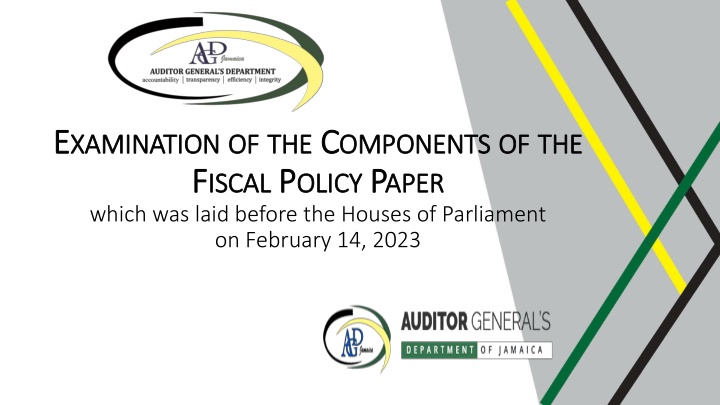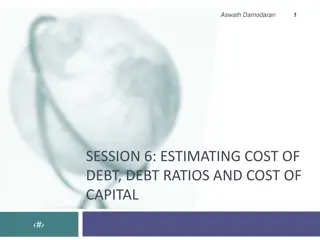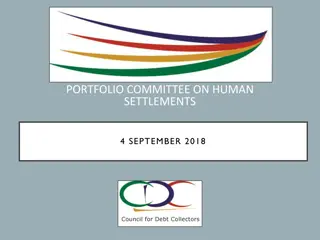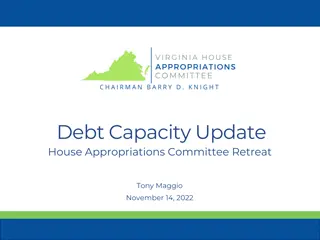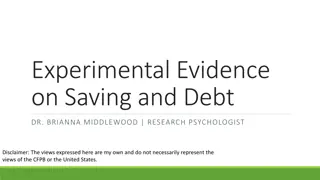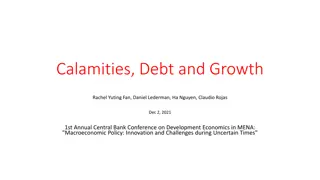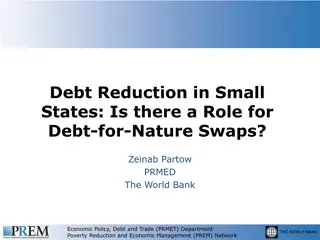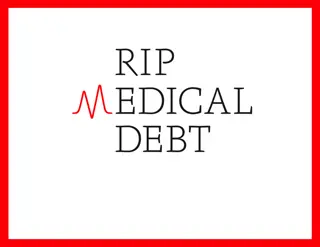US Federal Debt and National Economic Education
This presentation by the Kiwanis Club of Helena, MT explores the US Federal Debt, featuring insights from Amherst College Professor of Economics, Geoffrey Woglom. The National Economic Education Delegation aims to enhance public understanding of economic principles through nonpartisan discussions led by top economists. Topics cover a wide range including the US Economy, Immigration, Climate Change, and more, with a focus on the Federal Budget and deficits. Dive into rich data and analyses to gain a comprehensive view of economic policies and their impact on society.
Download Presentation

Please find below an Image/Link to download the presentation.
The content on the website is provided AS IS for your information and personal use only. It may not be sold, licensed, or shared on other websites without obtaining consent from the author.If you encounter any issues during the download, it is possible that the publisher has removed the file from their server.
You are allowed to download the files provided on this website for personal or commercial use, subject to the condition that they are used lawfully. All files are the property of their respective owners.
The content on the website is provided AS IS for your information and personal use only. It may not be sold, licensed, or shared on other websites without obtaining consent from the author.
E N D
Presentation Transcript
E EXAMINATION XAMINATION OF OF THE THE C COMPONENTS OMPONENTS OF F FISCAL ISCAL P POLICY OLICY P PAPER which was laid before the Houses of Parliament on February 14, 2023 OF THE THE APER
I reviewed the Fiscal Policy Paper (FPP), which was laid before the Houses of Parliament on February 14, 2023, in accordance with the Financial Administration and Audit (FAA) Act. Auditor Auditor General s General s Comments Comments The FPP met the requirements of the Third Schedule and included the minimum content under the Fiscal Responsibility Statement, Macroeconomic Framework and Fiscal Management Strategy. I adhered to the standards issued by the International Association of Supreme Audit Institutions and International Standard on Assurance Engagement (ISAE) 3000.
Auditor Generals Auditor General s Responsibilities Responsibilities Section 48B (6) of the FAA Act requires the Auditor General to examine the components of the Fiscal Policy Paper and provide a report to the Houses of Parliament indicating whether: - The Conventions & assumptions underlying preparation of the FPP comply with principles of prudent fiscal management. There are public bodies that do not form part of the specified public sector that were part thereof in the preceding fiscal year. Reasons given for deviations from the Budget are reasonable, having regard to the circumstances. A public private partnership involves only minimal contingent liabilities.
a) Regarding the conventions and assumptions underlying the preparation of the Fiscal Policy Paper The principles of prudent fiscal management require the budget to be informed by reasonable revenue projections, underpinned by realistic macroeconomic assumptions, and that related risks and risk-mitigating measures are identified For FY2023/24, nominal GDP growth of 9.1% (5.1% real) was projected in the context of a slowdown in the economic growth of advanced economies; The pace of growth was forecasted to decelerate over the medium term to 6.1 per cent (1.0 per cent real) against the backdrop of weakened global growth, elevated domestic and international inflation, and a tightened monetary policy stance.
a) Regarding the conventions and assumptions underlying the preparation of the Fiscal Policy Paper (contd.) The medium-term forecasts depicted Wage to GDP ratios of more than 11.0 per cent for FY2023/24 to FY2026/27, but no reference was made to the Wage to GDP legislative target of 9 per cent. Relatively small buffers in the form of fiscal surpluses of $9.9bn and $8.5bn for FY2023/24 and FY2024/25, respectively, were noted relative to the $21.3bn surplus for FY2021/22. Accordingly, the staff level agreement on a Precautionary and Liquidity Line (PLL) and the Resilience and Sustainability Facility (RSF) totalling US$1.7bn will provide important support to the budget.
a) Regarding the conventions and assumptions underlying the preparation of the Fiscal Policy Paper (cont d) The FPP identified slower than projected GDP growth as the main risk to fiscal and debt sustainability. This risk would be managed through continued monitoring of developments in the global economy to gauge spill over effects Other risks indicated, include those related to inflation, interest rates, oil price and Government s exposure to contingent liabilities for which risk-mitigating measures were also identified. Consequent on the impact of the COVID-19 pandemic, four of the five existing concessionaires submitted claims or notice of their intent to claim under the provisions of the respective concession agreements. The imperative is for the claims to be properly assessed and managed, to not present a risk to the fiscal position and debt trajectory.
a) Regarding the a) Regarding the conventions and conventions and assumptions assumptions underlying the underlying the preparation of the preparation of the Fiscal Policy Paper Fiscal Policy Paper (Cont d) (Cont d) Overall, I found that the conventions and assumptions underlying the preparation of the Fiscal Policy Paper FY2023/24 complied with the principles of prudent fiscal management.
b) Regarding explanations for deviation in revenue for April-Dec 2022 vis-a-vis Original budget The greater than budgeted non-tax revenue was attributed to higher than projected inflows from de- earmarked companies and miscellaneous revenue. Stronger than budgeted Production & Consumption taxes were reportedly fuelled by higher consumption associated with increased employment while Education Stronger than expected grant receipts reflected greater than expected disbursements from the European Union and Caribbean Development Bank. The FPP attributed the general overperformance of revenue to the country s strong recovery from the effects of the COVID-19 pandemic, as well as policies to address the economic impact of the Russia- Ukraine conflict Tax receipts also reflected labour market improvements
Explanations for deviation in revenue for April Dec 2022 vis-a- vis Original budget Overall I found the explanations for the deviations relative to Budget to be reasonable, having regard to the circumstances.
c) pursuant to my c) pursuant to my application of criteria application of criteria prescribed pursuant to prescribed pursuant to regulations made under regulations made under Section 50 (1), there are Section 50 (1), there are public bodies that do public bodies that do not form part of the not form part of the specified public sector, specified public sector, and identifying those and identifying those bodies (if any) which in bodies (if any) which in the preceding financial the preceding financial year formed part of the year formed part of the specified public sector: specified public sector: The FAA Act requires the Minister, no later than August 31, in every third year, to provide the Auditor General with a list of public bodies that the Minister wishes the Auditor General to consider for certification The Auditor General assessment confirmed that both JMB and the BOJ carry out functions primarily of a commercial nature as required by Regulations 14(2) of the FAA (FRF). Auditor General s certification for JMB Limited and BOJ was submitted to the Minister of Finance on September 29, 2022, and the report was tabled in Parliament on October 11, 2022.
d) a public private partnership involves only minimal contingent liabilities The FPP identified that the Jamaica Ship Registry was being considered as a user pays PPP but is no longer being pursued via PPP. GOJ indicated that alternative means of privatization will be explored. The FAA Act requires the Auditor General to assess whether a public private partnership (PPP) involves only minimal contingent liability accruing to the Government .
Fiscal Management Strategy Primary and Fiscal Balance For April to December 2022, the primary balance was $62.6 billion above target (110.4 %) whereas the fiscal balance was better than target by $55.5 billion (136.9 %). For FY2022/23, the estimate is for the fiscal surplus to be largely in line with the original budget based on higher than budgeted expenditure of 12.5 per cent and higher revenue by 12.4 per cent. The higher estimated primary balance for FY2022/23 reflects the higher estimated interest payments.
Tax Revenue Tax revenue for the period April to December 2022 outperformed target by $52.1 billion (11.2 per cent). Tax performance reflected higher than projected outturns in all three major tax categories: International Trade, Income & Profits and Production & Consumption. Tax Revenue is projected to fall to 27.9 per cent in FY2023/24 and then increase to 28.2 per cent by FY2026/27
Capital Expenditure Capital Expenditure for April to December 2022 was $5.9 billion (13.9 per cent) less than originally budgeted which the FPP FY2023/24 attributed to a deceleration in the pace of execution for several planned projects.. Capital Expenditure is projected to gradually increase over the medium- term; however, both in dollars and as a percentage of GDP, the projections represented a downward revision when compared to the projections in the previous FPP.
Wages and Salaries For April to December FY2022/23, Wages and Salaries exceeded original budget by $2.3 billion (1.1%). Wages and Salaries for FY2022/23 was estimated to be $39.9 billion, or 14.8% above the original budget, largely reflecting further payments to be made under the Public Sector Compensation Reform. Wages and Salaries has consistently exceeded the legislated target of 9 per cent over the years and is projected to remain above the target over the medium- term.
Public Debt Public Debt is estimated to end FY2022/23 at 79.7 per cent of GDP. 120 100 This estimated debt to GDP ratio represents a downward revision by 7.6 percentage point relative to the 87.3 per cent projected in the FPP FY2022/23. 80 60 40 The current estimates also represent a 4.4 percentage point improvement relative to the estimates presented in IMF Article IV 2022 consultation review. 20 0 Est Proj. 2023/24 80.1 74.2 77.9 Proj. 2024/25 73.9 68.2 74 Proj. 2025/26 68.9 63.6 70 Proj. 2026/27 Proj. 2027/28 2021/22 96.3 94.2 2022/23 87.3 79.7 84.1 FPP 2022 FPP 2023 IMF Article IV 2022 58.8 64.4 59.9
Recommendations Recommendations The FPP should disclose the government s intention for the wage to GDP legislative target of 9 per cent, given the current and projected breach over the medium-term.
